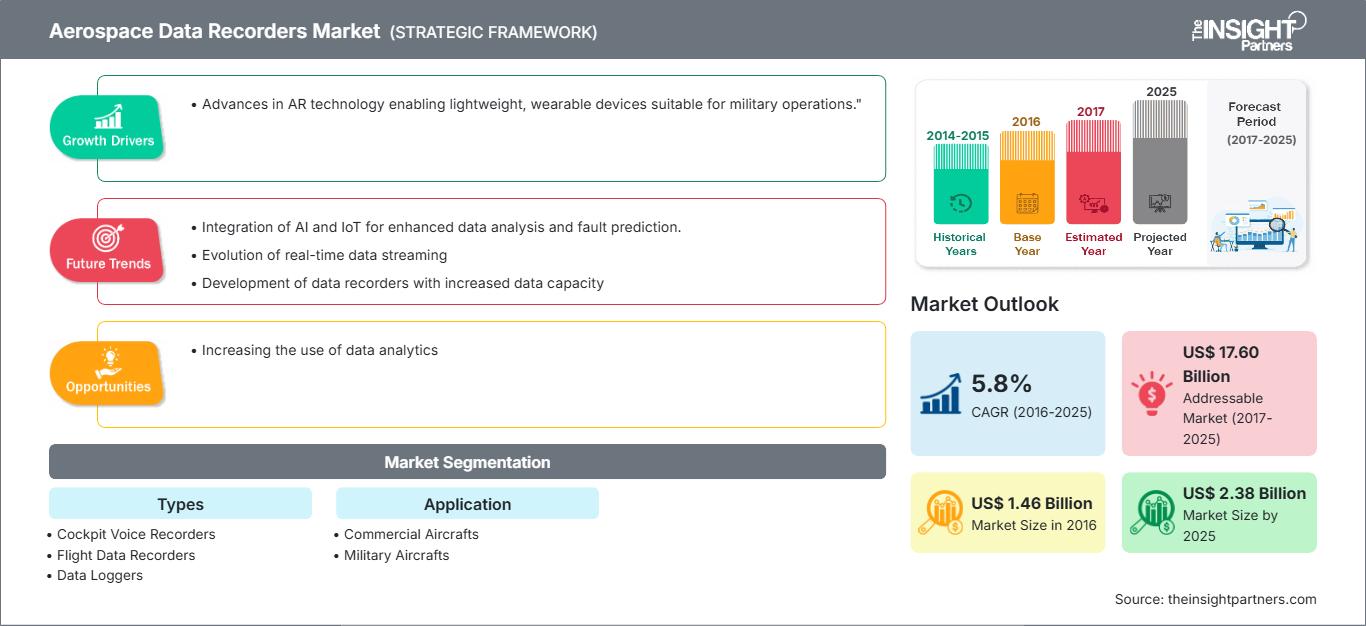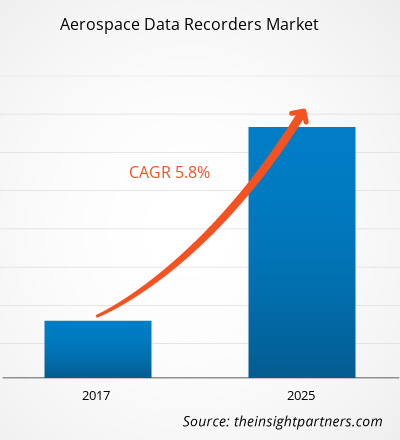En términos de ingresos, el mercado global de grabadoras de datos aeroespaciales se valoró en US$ 1.460,9 millones de dólares en 2016 y se proyecta que alcance los US$ 2.379,5 millones para 2025; se espera que crezca a una CAGR del 5,8% durante el período de pronóstico de 2017 a 2025.
El mercado de grabadoras de datos aeroespaciales está segmentado en cinco regiones principales: Norteamérica, Europa, Asia-Pacífico, Oriente Medio y África (MEA) y Sudamérica. Norteamérica es el mayor inversor en este mercado, gracias a la presencia de un gran número de fabricantes en la región. Además, el Departamento de Defensa de Estados Unidos es el principal contribuyente a la industria de defensa a nivel mundial. Europa se sitúa por detrás de Norteamérica en términos de inversión en el mercado de grabadoras de datos aeroespaciales. Airbus, el gigante aeronáutico, es uno de los principales generadores de ingresos de la región en este mercado. La región Asia-Pacífico está preparada para generar importantes ingresos en los próximos años gracias a la presencia de empresas emergentes de tecnología aeroespacial. Países como China, India, Japón y Corea del Sur están realizando importantes inversiones para fabricar componentes aeronáuticos avanzados.
Perspectivas del mercado: mercado de grabadoras de datos aeroespaciales
Aumento de los programas de modernización de aeronaves
La industria aeroespacial mundial está experimentando un rápido aumento del tráfico aéreo, lo que exige aeronaves avanzadas, tanto en el sector comercial como en el militar. Debido a esto, tanto las aerolíneas comerciales como las fuerzas de defensa están transformando los sistemas convencionales en tecnologías robustas para sus aeronaves de ala fija, aeronaves de ala rotatoria y vehículos aéreos no tripulados. La modernización de las aeronaves incluye nuevos motores, modernos sistemas de comunicación digital, trenes de aterrizaje y frenos tecnológicamente mejorados, armamento avanzado y sistemas de navegación de vuelo, sistemas de entretenimiento a bordo y grabadoras de datos, entre otros. La modernización de las aeronaves beneficia a los fabricantes de grabadoras de datos, ya que estas son más pequeñas, más fiables, más rápidas, con mayor capacidad de almacenamiento, más precisas y ligeras. Estas ventajas aumentan el interés de las fuerzas de defensa y las aerolíneas comerciales por modernizar los sistemas de adquisición de datos para facilitar el proceso de investigación. Por lo tanto, la modernización de aeronaves, helicópteros y vehículos aéreos no tripulados impulsa el crecimiento de las grabadoras de datos aeroespaciales.
Obtendrá personalización en cualquier informe, sin cargo, incluidas partes de este informe o análisis a nivel de país, paquete de datos de Excel, así como también grandes ofertas y descuentos para empresas emergentes y universidades.
Mercado de grabadoras de datos aeroespaciales: Perspectivas estratégicas

- Obtenga las principales tendencias clave del mercado de este informe.Esta muestra GRATUITA incluirá análisis de datos, desde tendencias del mercado hasta estimaciones y pronósticos.
Información sobre segmentos de tipo
Según el tipo, el segmento de grabadoras de datos de vuelo dominó el mercado global de grabadoras de datos aeroespaciales en 2016. Debido al desarrollo de las grabadoras de datos de vuelo en términos de tiempo de grabación, parámetros de grabación y transmisión de datos en tiempo real a tierra, se espera que el mercado de grabadoras de datos de vuelo aumente durante el período.
Información sobre segmentos de aplicaciones
En términos de aplicación, el segmento de aeronaves comerciales ocupó la mayor participación en el mercado mundial de grabadoras de datos aeroespaciales en 2016. La aviación comercial está creciendo a un ritmo acelerado a nivel mundial, lo que ha generado un aumento significativo en los pedidos y la fabricación de aeronaves. Las principales aerolíneas comerciales están aumentando sus flotas a nivel mundial para satisfacer la creciente demanda. Otro factor clave que impulsa el mercado de grabadoras de datos aeroespaciales en la aviación comercial es la creciente demanda de transmisión de datos aire-tierra en tiempo real.
Los actores del mercado se centran en innovaciones y desarrollos de nuevos productos integrando tecnologías y características avanzadas en sus productos para competir con la competencia.
- En 2017, Airbus, en colaboración con L3 Technologies, lanzó una nueva grabadora de datos de vuelo y voz, fija y desplegable. Esta grabadora tendrá una duración extendida de 25 horas.
- En 2017, RUAG Holdings AG completó 15.000 mantenimientos de registradores de datos de vuelo. La empresa garantiza un tiempo máximo de mantenimiento de 3 días para cada componente del registrador de datos de vuelo.
- En 2016, Honeywell International Inc. actualizará las grabadoras de datos de vuelo de GoAir con sus grabadoras de datos avanzadas que facilitarán a las aerolíneas un conocimiento sólido de la situación y más información sobre el vuelo.
Perspectivas regionales del mercado de grabadoras de datos aeroespaciales
Los analistas de The Insight Partners han explicado detalladamente las tendencias regionales y los factores que influyen en el mercado de grabadoras de datos aeroespaciales durante el período de pronóstico. Esta sección también analiza los segmentos y la geografía del mercado de grabadoras de datos aeroespaciales en América del Norte, Europa, Asia Pacífico, Oriente Medio y África, y América del Sur y Central.
Alcance del informe de mercado de grabadoras de datos aeroespaciales
| Atributo del informe | Detalles |
|---|---|
| Tamaño del mercado en 2016 | 1.460 millones de dólares estadounidenses |
| Tamaño del mercado en 2025 | US$ 2.38 mil millones |
| CAGR global (2016-2025) | 5,8% |
| Datos históricos | 2014-2015 |
| Período de pronóstico | 2017-2025 |
| Segmentos cubiertos | Por tipos
|
| Regiones y países cubiertos | América del norte
|
| Líderes del mercado y perfiles de empresas clave |
|
Densidad de actores del mercado de grabadoras de datos aeroespaciales: comprensión de su impacto en la dinámica empresarial
El mercado de grabadoras de datos aeroespaciales está creciendo rápidamente, impulsado por la creciente demanda de los usuarios finales debido a factores como la evolución de las preferencias de los consumidores, los avances tecnológicos y un mayor conocimiento de las ventajas del producto. A medida que aumenta la demanda, las empresas amplían su oferta, innovan para satisfacer las necesidades de los consumidores y aprovechan las tendencias emergentes, lo que impulsa aún más el crecimiento del mercado.

- Obtenga una descripción general de los principales actores clave del mercado de grabadoras de datos aeroespaciales
El mercado global de grabadoras de datos aeroespaciales se ha segmentado de la siguiente manera:
Mercado de grabadoras de datos aeroespaciales: por tipos
- Grabadoras de voz de cabina
- Registradores de datos de vuelo
- Registradores de datos
- Grabadoras de acceso rápido
Mercado de grabadoras de datos aeroespaciales: por aplicación
- Comercial
- Militar
Mercado de grabadoras de datos aeroespaciales por región
- América del norte
- A NOSOTROS
- Canadá
- México
- Europa
- Alemania
- Reino Unido
- Rusia
- Italia
- Resto de Europa
- Asia Pacífico (APAC)
- Porcelana
- India
- Japón
- Resto de APAC
- Oriente Medio y África (MEA)
- Sudáfrica
- Arabia Saudita
- Emiratos Árabes Unidos
- Resto de MEA
- América del Sur (SAM)
- Brasil
- Resto de SAM
Mercado de grabadoras de datos aeroespaciales: perfiles de empresas
- Honeywell International Inc.
- Tecnologías Teledyne
- RUAG AG
- Corporación de sistemas de aviónica universal
- Tecnologías L3Harris
- Soluciones de defensa Curtiss-Wright
- AstroNova Inc.
- Soluciones aeroespaciales FLYHT Ltd.
- Leonardo Dr.
- MadgeTech Inc.
- Análisis histórico (2 años), año base, pronóstico (7 años) con CAGR
- Análisis PEST y FODA
- Tamaño del mercado, valor/volumen: global, regional y nacional
- Industria y panorama competitivo
- Conjunto de datos de Excel
Informes recientes
Informes relacionados
Testimonios
Razón para comprar
- Toma de decisiones informada
- Comprensión de la dinámica del mercado
- Análisis competitivo
- Información sobre clientes
- Pronósticos del mercado
- Mitigación de riesgos
- Planificación estratégica
- Justificación de la inversión
- Identificación de mercados emergentes
- Mejora de las estrategias de marketing
- Impulso de la eficiencia operativa
- Alineación con las tendencias regulatorias




















 Obtenga una muestra gratuita para - Mercado de grabadoras de datos aeroespaciales
Obtenga una muestra gratuita para - Mercado de grabadoras de datos aeroespaciales